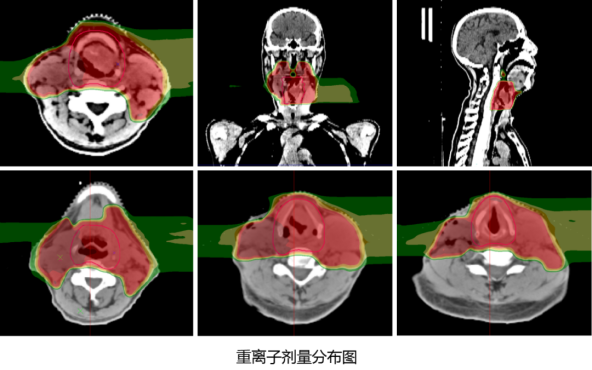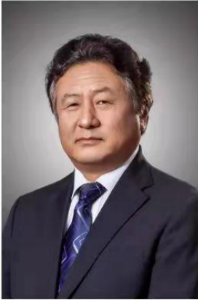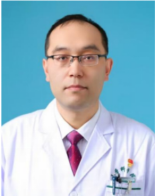"Precision Proton Therapy: Voice-Sparing Innovation in Laryngeal Oncology"
"Precision Proton Assault: Revolutionizing Laryngeal Cancer Care Through Vocal Cord Preservation"

Lu Jing
Chief Physician
Department of Radiotherapy, Lanzhou Branch (Lanzhou Heavy Ion Center)
Gansu Wuwei Cancer Hospital
In early 2023, while everyone was immersed in the joy of welcoming the New Year, 81-year-old Mr. Gao suddenly developed experienced hoarseness. Initially, neither Mr. Gao nor his family paid much attention, assuming it was just a "cold" that would resolve with medication and rest. However, the hoarseness worsened, accompanied by progressive dyspnea (difficulty breathing) and呛咳 (choking during swallowing). This alarming progression prompted them to seek emergency care at a hospital, where laryngoscopy, CT imaging, and biopsy confirmed a diagnosis of laryngeal cancer. The tumor measured an alarming 44×36 mm, causing severe narrowing of the hypopharynx and invasion into the thyroid cartilage and surrounding tissues. By this point, Mr. Gao could only breathe while sitting upright and panting through an open mouth. To prevent asphyxiation, the hospital's head and neck surgery team performed a tracheostomy with laryngeal cannula placement, temporarily alleviating his breathing difficulties. Yet, the next steps in treatment posed a significant dilemma for the family.


The family first learned about surgical treatment, which required a total laryngectomy. However, for 81-year-old Mr. Gao, who had a history of "cerebral infarction," this posed an insurmountable challenge. Postoperatively, he would lose his voice and rely solely on gestures and writing for communication. Additionally, he faced risks such as long-term nasogastric feeding, increased susceptibility to pulmonary infections due to metal tracheostomy tube use, and aspiration pneumonia from recurrent nerve damage or resection—factors that caused Mr. Gao to lose confidence in continuing treatment. Fortunately, after extensive consultations, the family learned that carbon ion beam therapy (CIRT) could achieve effective tumor control with minimal side effects, sparing Mr. Gao from such hardships. They promptly chose to receive treatment at the Gansu Wuwei Cancer Hospital's Heavy Ion Therapy Center's Radiation Oncology Department.
Upon admission, the head and neck tumor CIRT team designed a 23-session treatment plan for Mr. Gao. After 10 sessions, his hoarseness significantly improved, and the tracheostomy tube was removed after 16 sessions. Post-treatment MRI re-examination showed complete resolution of the lesion and marked improvement in laryngeal stenosis, achieving a complete response (CR) reflecting on his journey, Mr. Gao realized he had not only conquered laryngeal cancer but also regained hope and courage in life through the remarkable efficacy of CIRT.


Efficacy comparison chart
Laryngeal cancer accounts for approximately 1%-2% of all malignant tumors in the body and is the second most common cancer in the respiratory tract, second only to lung cancer. It is most prevalent among male smokers aged 40-70. Currently, the cure rate for early-stage laryngeal cancer exceeds 80%-90%. For intermediate-stage disease, treatment efficacy is more challenging, with a 5-year survival rate of around 60%. In advanced stages, the 5-year survival rate drops significantly to about 30%, making cure difficult.
Carbon ion beam therapy (CIRT) for laryngeal tumors achieves precise dose escalation while fully protecting at-risk organs, thereby minimizing acute and chronic treatment-related side effects. This approach enhances local control rates and reduces toxicity. Our center has treated over 30 hypopharyngeal and laryngeal cancer cases with CIRT, successfully preserving patients' vocal and swallowing functions.
Professor Junjie Wang's Clinical Research Team
Lanzhou Heavy Ion Center

Wang Junjie
Chief Physician, Professor
Currently serves as Director of the Department of Radiation Oncology at Peking University Third Hospital, Doctoral Supervisor, Director of the Brachytherapy Center at Peking University Health Science Center, and Deputy Director of the Department of Radiation Oncology at Peking University
Chairman of the 10th Committee of the Society of Radiation Oncology, Chinese Medical Association
Inaugural Chairman of the Brachytherapy and Intelligent Radiotherapy Society of the Chinese Nuclear Society
Vice Chairman of the Minimally Invasive Therapy Committee of the Chinese Anti-Cancer Association
Chairman of the Radioactive Particle Ablation Technology Committee of the National Strategic Alliance for Technological Innovation in Tumor Minimally Invasive Therapy Industry
Associate Editor-in-Chief of the Chinese Journal of Radiological Medicine and Protection
Editorial Board Member of the American journal Brachytherapy

Li Xiaojun
Chief Physician, Vice President
Currently serving as Assistant Dean of Gansu Province Wuwei Cancer Hospital and Vice President of Lanzhou Proton and Heavy Ion Hospital
Gansu Province Longyuan Youth Talent, Gansu Province Health Industry Outstanding Youth Talent
Heir of Traditional Chinese Medicine (TCM) at Gansu Provincial Health Commission
Visited the RPTC Proton Center in Munich, Germany; studied at the Shanghai Proton and Heavy Ion Hospital, Beijing Cancer Hospital, Sichuan Cancer Hospital, and the Varian Training Center in the USA
Specializes in radiation therapy for tumors of the central nervous system, head and neck, chest, abdominal and pelvic regions, and extremities
Awarded the Second Prize of Gansu Provincial Science and Technology Progress and multiple science and technology progress awards in Wuwei City
Led and participated in over 10 provincial and municipal research projects, including major provincial science and technology special projects and key talent programs of the Provincial Party Committee Organization Departmen
Published 7 SCI papers as the first/corresponding author and over 30 papers in domestic core journals; holds 10+ invention and utility model patents for radiation therapy
Clinic Schedule: Monday to Friday, 5th Floor of the Inpatient Department, Lanzhou Campus
